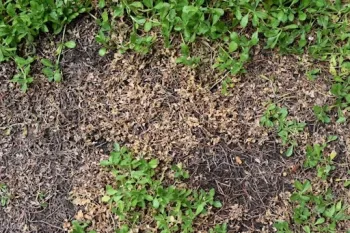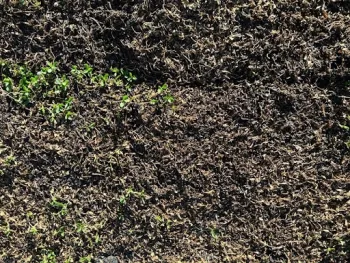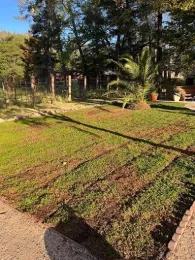by Cynthia Kerson
This is the third installment of our kurapia saga. We re-laid the kurapia mid-March, so it has been on the ground for about six weeks. A crew of four laid it in about 3 hours. It took my husband and me 2 days in 2019. They cleaned up the mulch and any undecomposed cardboard, leveled some areas, and plunked it down.
We were glad when they asked if we wanted to put it down this early in the year since we wouldn't have to water it as much as if we waited till May. This is, of course, because we expected cooler temperatures and some rain, neither of which transpired during the first 3 weeks. That said, we were very careful to water less than our hearts wanted to. Early morning and evening, we hand-watered. We'd lift a corner to see if the soil below was wet, and it was – down to about 2 or 3 inches. At 3 weeks we stopped lifting the sod, or would never set. We're pretty confident we're watering just right.

We were told that any brown areas could be a signal that we're not watering enough, but also that we should expect some areas to die off as some of the Kurapia fails to root. This is temporary and the broadleaf will fill in those areas within no time. That's exactly what's been happening. After about 1½ weeks, we saw some deadening areas, but now at about 6 weeks, those areas are filling in. It really was an emotional struggle to not overwater those deadening areas.
Here is the image from 2019 with the overwatered section with a fungal disease.

Last, as everyone knows, it rained! We got 2.25” last week. This spared us the trouble of hand watering, but I did worry that it would be too much water. Plus, it got pretty cold a few nights. It's supposed to warm up and possibly rain some more this week. It would have survived these elements while at the kurapia farm, so it should be OK here.

Napa Master Gardeners are available to answer garden questions by email: mastergardeners@countyofnapa.org. or phone at 707-253-4143. Volunteers will get back to you after they research answers to your questions.
Visit our website: napamg.ucanr.edu to find answers to all of your horticultural questions.
Photo credits: Cynthia Kerson
Information links: UC Davis-Kurapia https://ccuh.ucdavis.edu/kurapia
UC IPM-Management of Soilborne Pathogens

